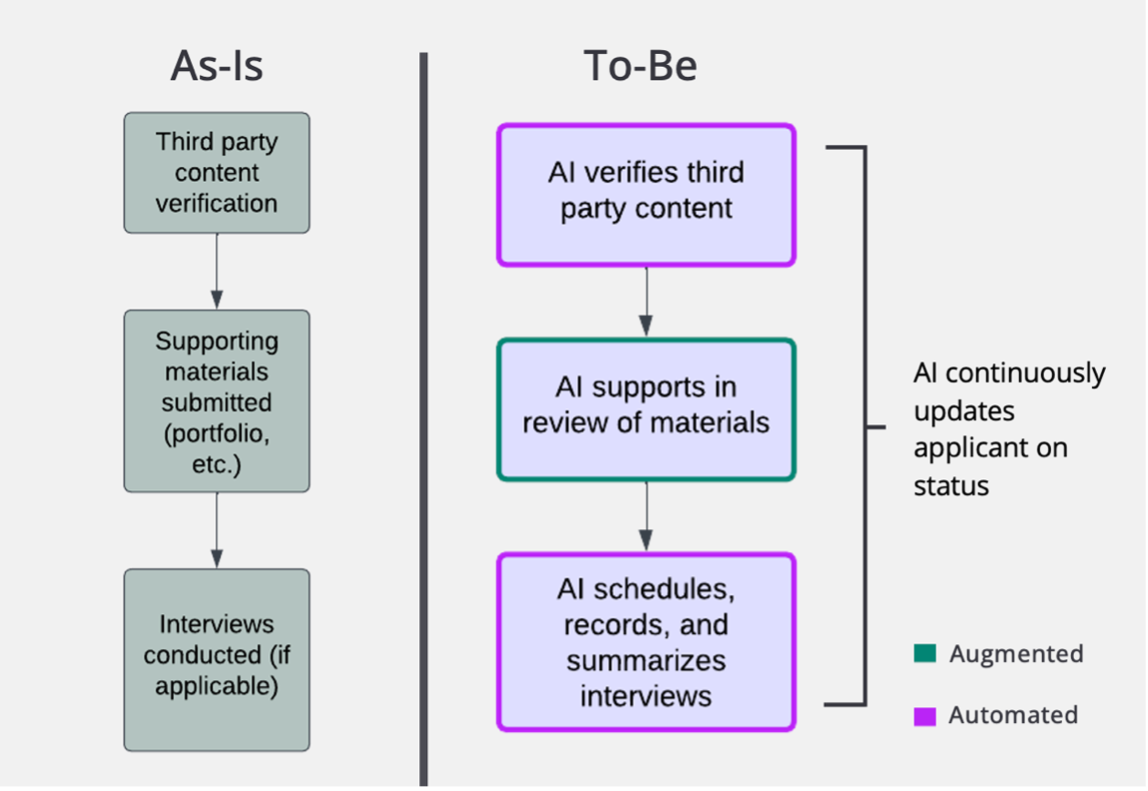This series (read part 1 here) is dedicated to exploring the role of AI augmentation in revolutionizing the certification process. AI augmentation, which aims to enhance and complement human capabilities rather than replace them, holds the promise of streamlining and optimizing various facets of certification. From automating data collection and validation to improving decision-making and communication, AI augmentation can significantly reduce bottlenecks, errors, and delays, leading to a more efficient and effective certification journey. Keep in mind, processes vary considerably from one association to the next, so this is just an example of the process to draw inspiration from.
Welcome to Part 2 of Sidecar’s series on the transformative potential of AI augmentation in the certification process. To recap, in Part 1 we discussed the intricacies of certification, highlighting its significance in affirming the competence and credibility of professionals across various industries. We also shed light on the challenges that often accompany traditional certification processes, including their complexity, time-consuming nature, and the costs involved for both applicants and certifying bodies. Part 1 is dedicated to the first two processes within the certification process: application and preliminary review. In this article, we will discuss the requirements validation and committee review and approval processes and how both of these sub-processes can be enhanced with the use of AI.
Remember, processes vary considerably from one association to the next, so use this as an example of the processes to draw inspiration from. When stepping back to evaluate your organization’s certification process and how AI can help streamline it, take the pieces of this article that fit for you, and leave the ones that don’t. Now, let’s dive in...
The Requirements Validation Process
The requirements validation process is sometimes a separate step in the process, where the materials submitted in the application are validated a number of possible ways. In some cases, certifying bodies take the application “at its word”, but in others there is a rigorous diligence process to validate the legitimacy and accuracy of the information submitted. Some common steps and challenges are:
- Manual checking of third-party content; time-consuming and tedious.
- Reviewing additional materials; time-consuming and may involve biases.
- Scheduling and conducting interviews; adds friction to the process.
- Manual process; costly and time-consuming, potentially leading to applicant dissatisfaction due to lengthy wait times.
The requirements validation process can be improved by:
- Using AI to design and deliver the examination or the assessment.
- Applications:
- Using ML to generate and adapt the questions and answers.
- Using LLMs to evaluate and grade the responses.
- Applications:
- Using AI to analyze and optimize the score or the grade.
- Applications:
- Using ML to calibrate and normalize the scores.
- Using LLMs to provide and justify the feedback.
- Applications:
- Using AI to create and review the portfolio or the project.
- Applications:
- Using ML to generate and customize the tasks and the criteria.
- Using LLMs to evaluate and comment on the work.
- Applications:
- Using AI to conduct and record the interview or the presentation.
- Applications:
- Using LLMs to generate and ask the questions and the feedback.
- Using computer vision to analyze and capture the expressions and the gestures.
- Applications:
- Using AI to accelerate and update the results and the feedback of the requirements validation.
- Applications:
- Using ML to automate and streamline the scoring and the reporting.
- Using LLMs to generate and send notifications and reminders.
- Applications:

The Committee Review and Approval Process
The committee review and approval process typically occurs in higher stakes professions where a formal review by experts in the field (e.g. volunteer leaders on a committee). The certifying body convenes a committee of experts and stakeholders to review and approve the applicants who have passed the earlier phases in the process. The committee review and approval process can also vary depending on the type, level, and scope of the certification, as well as the policies and procedures of the certifying body. However, some common steps and challenges are:
- Selection process for committee members; can include staff, volunteers, external experts, or profession representatives.
- Review and deliberation on applications; time-consuming, scheduling challenges, and potential biases.
- Communication of decision and feedback to applicants; options for appeal or reapplication.
- Documentation, archiving, and evaluation of decisions, feedback, and certification outcomes.
The committee review and approval process can be improved by:
- Using AI to automate and standardize the committee selection and invitation.
- Applications:
- Using ML to match and recommend the committee members.
- Using LLMs to generate and send the invitations and the agendas.
- Applications:
- Using AI to augment and support the committee review and discussion.
- Applications:
- Using LLMs to summarize and highlight the key information and issues.
- Using ML to provide suggestions and recommendations.
- Applications:
- Using AI to monitor and improve the quality and fairness of the committee decision and feedback.
- Applications:
- Using ML to detect and correct errors, anomalies, and biases.
- Using LLMs to generate and explain the rationale and evidence for the decision.
- Applications:
- Using AI to facilitate and enhance the communication and interaction of the committee decision and feedback.
- Applications:
- Using LLMs to generate and send personalized and timely messages.
- Using chatbots to handle appeals and reapplications.
- Applications:
- Using AI to accelerate and update the documentation and reporting of the committee decision and feedback.
- Applications:
- Using LLMs to generate and archive the records and the reports.
- Using ML to analyze and evaluate the performance and the outcomes of the certification process.
- Applications:

Impact of AI on Stage 3 & 4 of the Certification Process
By harnessing the power of AI to compile and summarize application materials, committees are afforded enriched insights and a comprehensive perspective of each applicant, paving the way for more informed and holistic evaluations. This automation of administrative tasks liberates committee members from manual processes, allowing them to dedicate their time and efforts to decision-making, in turn enhancing the depth and quality of reviews. In addition, AI's ability to process expansive datasets uncovers emerging trends and predictive insights, offering committee members a forward-looking view that can shape the professional landscape and inform future standards. This integrative approach facilitated by AI not only streamlines procedures but also elevates the certification process to new heights of precision and relevancy.
Integrate AI into Your Certification Process Today
As we conclude Part 2 of this series it's clear that the requirements validation and committee review and approval processes, traditionally seen as some of the most resource-intensive aspects of certification, are poised for a significant transformation. By incorporating AI, associations can address and alleviate the intensive manual labor associated with these stages, reducing time, costs, and human error. AI's capabilities—from deploying machine learning to generate adaptive assessments to employing large language models for detailed evaluations—create a certification process that is not only more efficient but also more equitable and just. This innovative approach ensures that candidates are evaluated fairly, with AI tools providing consistency and unbiased support.
Looking to incorporate AI within your organization? Sidecar’s AI Learning Hub is the perfect place to start! Head here for more information.

April 1, 2024



